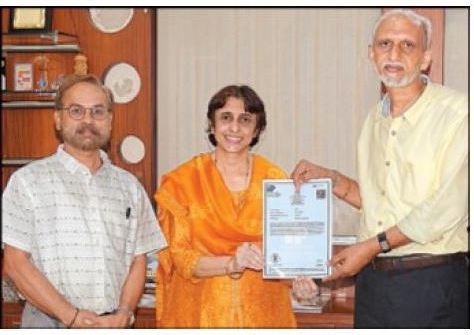Use of watermelon seeds can do crack healing of concrete
| Date :03-Jul-2021 |

- VNIT Professor Dr Madhuwanti Latkar comes up with the conclusion after 6 years of research and she gets patent too
RESEARCHERS atVisvesvaraya National Institute ofTechnology ( VNIT ), in their innovative research work, have proved that biocementation using watermelon seeds can strengthen and heal cementitious materials. Today, due to increase in demand of durable building materials, there is requirement of efficient techniques to augment the physico-mechanical properties of cementitious materials.
Durability of structures is a prime issue, and a large amount of money has already been invested in it. Presently, a number of chemical admixtures are used for crack healing as well as to increase durability of structures. Using chemical admixtures has many drawbacks such as high cost and environmental pollution. A research team in Department of Civil Engineering, VNIT, under guidance of Dr Madhuwanti Latkar, Associate Professor, has been working for about last 6 years in the area of Biocementation to find out several innovative ways to strengthen and heal cement-based materials.The researchers claim that biocementation using watermelon seeds is the best environment-friendly and economically feasible approach to ameliorate strength of structures, and also a best solution for crack healing of structures. A patent has been granted by Indian patent Office to Dr Latkar and team on this work. The principal investigator, Dr Madhuwanti Latkar, Associate Professor, Department of Civil Engineering, VNIT is one of the leading researchers in India in the area of biocementation.
She has published several research articles in many esteemed international journals and has also presented her work in various International and National Conferences. She also has four patents to her credit in this research area, granted by Indian Patent Office. As per Dr Latkar, "Watermelon seeds are magic beans when it comes to imparting strength to cementitious materials." The watermelon seeds are innately very rich in an enzyme called unease. This enzyme is the key player in the biocementation process, causing strength enhancement of cementitious materials. Snigdha Bhutange, a research scholar working under Dr Latkar's guidance has performed multiple experiments to establish statistical reliability of the work. The research is mentored by Dr Tapan Chakrabarti, former Director, NEERI, Nagpur and former Chair Professor (MPCB), VNIT. Dr Latkar reported around 22% increment in compressive strength and 19% reduction in water absorption, in seeds' blended concrete specimens as compared to conventional concrete.The biocemented concrete also qualified various durability tests, and in fact proved to be significantly more durable than conventional concrete.This technology has also been proved to be excellent in crack healing of concrete.
This is one of the best technologies to heal and strengthen concrete so far. Most of the biocementation techniques involve use of ureolytic bacteria. However, factors such as involvement of bacteria, nutritional requirements to grow the bacteria and experts' supervision to successfully achieve the purpose may limit the on-site application of biocementation using bacteria. This also may impart additional cost. Use of powdered seeds instead of bacteria as a source of urease, eliminates all these disadvantages. It reduces overall cost of the process, as it does not require special supervision or maintenance like that required for ureolytic bacteria. Storage and maintenance of seeds is much easier than that of bacteria, thus making the process practicable. Watermelon seeds which are of inferior quality, and regarded as waste material can be effectively used for biocementation purpose to make the process practicable and economical. Thus, use of watermelon seeds for biocementation overcomes all the drawbacks of other biocementation processes which use bacteria. Dr Latkar explained, laboratory scale studies have shown excellent results for both strength enhancement as well as crack healing of concrete using this technology. On-field validation of this technology is initiated. Once the field applicability of this technology is established, this environment friendly technique would certainly prove to be a major tool in achieving sustainable development, added Dr Latkar.